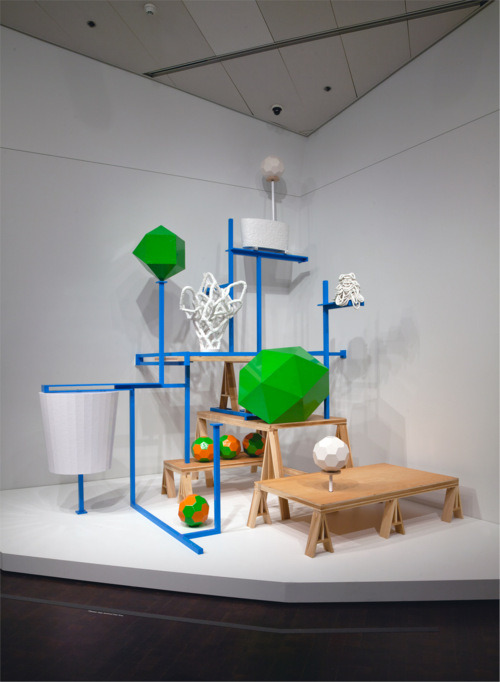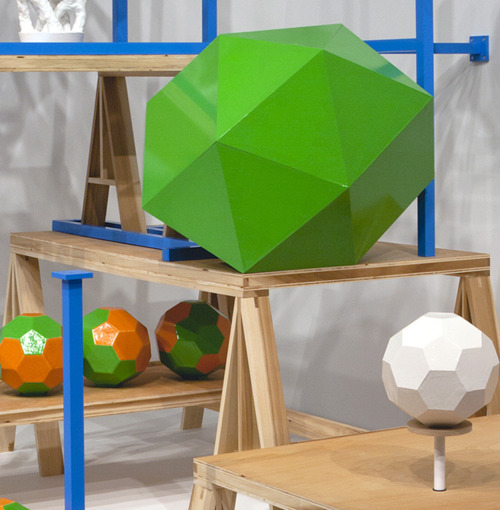
Paul Sacaridiz, An Incomplete Articulation, 2011. Cast, extruded, pinched ceramic, wood, powder coated aluminium, cut vinyl, board. Photo by Jeff Wells.
Tell us about the work you exhibited at the Overthrown: Clay Without Limits exhibition.
An incomplete articulation is a new work designed for the Denver Art Museum. The piece utilizes the conceptual framework of a schematic diagram to point towards differing ways of articulating form. Sagging mounds of ceramic extrusions are situated alongside precise mathematical models and awkward structural forms. Individual components are physically and conceptually networked together, creating an elaborate three-dimensional system of mapping that becomes suggestive of propositional models and utopian systems. The work is comprised of objects that are intentionally fabricated in a variety of ways, ranging from digitally rendered and prototyped to more direct, analog processes.
Does your work, An Incomplete Articulation, trying to reach an agreement between simple/ decorative and geometric/ architectural forms?
For a number of years, my work has looked at the visual correlation between domestic objects, such as decorative food molds, and the actual structures of built architecture. In many of these works, the approach to abstraction has relied upon decoration and pattern becoming something structural, rather than simply applied to a surface. An incomplete articulation follows this approach but is less metaphorical than past projects. Ultimately, the piece is a response to considering systems of abstraction and the seemingly impossible task of understanding something in its entirety.
You have an amazing ability to transform everyday forms and simple objects into a complex statement. Isn’t it hard? From our experience, keeping it simple is sometimes the hardest thing to do.
There is a tipping point in every piece, that place where what you have done is simply too much. One of the greatest challenges that I set for myself is figuring out what can be removed before the overall work starts to break down. This results in a very slow pace of observing and responding to a piece of sculpture. As time has passed, I am most interested in exploring a sculptural logic that is both pragmatic and highly allusive at the same time. This relies on a specific balance, which has to be reevaluated with each project.

Paul Sacaridiz, An Incomplete Articulation, detail, 2011. Cast, extruded, pinched ceramic, wood, powder coated aluminium, cut vinyl, board. Photo by Jeff Wells.
What advice can you give to those who look at your works? Should they be aware of something in particular?
Looking at sculpture should be experiential; the scale of the work and its materiality are as critical to the overall reading as conceptual concerns. Viewing work should never be a passive activity, and one needs to be engaged in deciphering images and objects at a multitude of levels. If I have done my job, correctly there will be multiple entry points in any given piece. There are many tropes that allow this to happen, and they should be taken as such. If an object appears to be beautiful or illogical, it can operate on an emotive or philosophical level. Both are equally valuable, and afford a jumping off point from which one can look at something from a position of curiosity, questioning and wonder.
Where can we find you and your works in the next future?
I am on the faculty at the University of Wisconsin-Madison and will be teaching a workshop next summer at the Haystack Mountain School of Crafts, in Deer Isle, Maine. Over the next year, I will be working on a project that seeks to explore the limitations of three-dimensional scanning and the possibility of translating that information into tangible objects. Scanning is successful with objects that are solid volumes and, therefore “readable” as a continuous surface. My primary interest is in scanning things that are not single surfaces, but rather conglomerations of multiple layers. Such information may prove challenging, if not impossible to fully record, resulting in a surface that is technically a failure in terms of the computers ability to read and render it in a complete mathematical state. I see this research as being as much a question of physical possibilities and limitations (of machinery, technology, etc…) as a philosophical investigation into abstraction and the limitations of understanding something that is perhaps impossible to fully grasp.
Paul Sacaridiz (b.1970, Brooklyn, NY, lives and works in Madison, WI) received an MFA (1998) from the School of the Art Institute of Chicago, and a BFA from Alfred University (1993).
Since 1997 he has been active in solo exhibitions, collaborative projects and group shows at a diverse number of venues including: The Philadelphia Museum of Art, The Madison Museum of Contemporary Art, the Icheon World Ceramic Center, Icheon, Korea, The Dubuque Museum of Art (IA), The Alfedena Gallery, Chicago, The Northern Illinois University Art Museum and the Ceramic Research Center at Arizona State University. His work has been the subject of reviews and articles in Ceramics: Art and Perception, The New Art Examiner and Art Papers among others. Sacaridiz has been the recipient of residencies at the Watershed Center for the Ceramic Arts, The Ragdale Foundation, The Vermont Studio Center and the Art/Industry Program at Kohler Company.
He is currently an Associate Professor in the Art Department at the University of Wisconsin-Madison.
By Vasi Hirdo.
Published in Ceramics Now Magazine Issue 1.
Visit Paul Sacaridiz’s website.



















